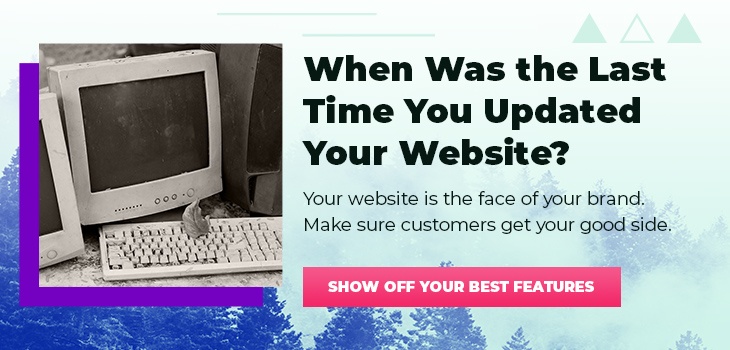In many ways, the web is still a lot like the Wild West. There’s a lot of desirable territory and brands are duking it out to stake their claim in the best spots to attract customers. Google is John Wayne riding around on his horse with a shiny revolver, enforcing the loose laws of the land.
The point is: Online competition is fierce, and the stakes are too high to rely on a website homepage that doesn’t attract and convert users. Your homepage is people’s first impression of your brand and should immediately grab their attention and encourage them to dive deeper.
How to do it? With two major elements: messaging and web design.
There are tons of things to get bogged down in while building your homepage, but keeping your focus on those two elements will ensure the final product is not only attractive but valuable too.
I talked to our Creative Team Lead Vanessa Wolfe about the five most important parts of your homepage design and how they contribute to overall website success.
#1 Clear Messaging
Messaging is critical for keeping people on your website. Your messaging framework should engage potential customers by highlighting their pain points and presenting your solution. Most importantly, they need to immediately know who you are and what you do when they land on your homepage.
“Prior to messaging is doing UX research to really understand what your users are looking for,” Vanessa explains. “This helps you create that copy with your audience in mind and better cater your messaging to their pain points.”
She advises businesses to focus on developing a clear headline and tagline at the top of their website. It doesn’t have to be anything flashy or witty. Simplicity and clarity are the keys to success on your homepage. If your service is streamlining tax filing, your tagline could be “Making taxes easy.”
Remember that people don’t read your whole website, they scan the sections. Keeping your copy simple makes it easier to identify if your solution is right for them.
From there, you’ll start building the story that engages users and walks them through the website. “When your user comes to your site, you’re giving them this experience through copy and imagery. Everything from the colors, composition of elements and the language used will create this experience for the user as they navigate through a page. And it starts on your homepage,” Vanessa says.
It should also be clear what you want website visitors to do. In addition to your primary call to action (CTA) — which we’ll discuss later in this post — you should include secondary CTAs throughout the page that all request the same thing.
- “Book a call”
- “Download your guide”
- “Meet our sales team”
Whatever it is you want users to do, give them clear directions and make it easy. Add a button, a link or a scheduling app right there on the page so all they have to do is click.
#2 Design
There are a handful of critical website design elements that can make or break your homepage. Among them, Vanessa notes:
- Website navigation
- Header image and text
- Primary CTA
- Responsiveness
Vanessa stresses that your homepage navigation menu should be easy to understand and use. “As a rule of thumb, there should be no more than five items on your main navigation. If you have more than that, consider using dropdown menus to categorize users’ options.”
This could mean putting all your product pages in a category labeled “Products” or your blogs, case studies and industry information in a “Resources” tab. You can also include a search bar in your main navigation to make it easy for people to find exactly what they’re looking for on your site without going through the various category levels.
Your website's header image and text should be large and in charge. The image — whether it’s a photo, graphic, animation or illustration — should immediately capture a user’s attention. Your text should concisely tell people what you do and match the image you chose. These two elements will work together to create your website's overall feel and tone.
Next, you can look at your primary CTA. According to the StoryBrand Framework, your primary CTA should be at the top right corner of your website and repeated throughout the page. “Be sure to use bold colors for your CTA,” Vanessa notes, “and a high-contrast font color. This helps the button stand out from your site and makes it easy for people to read what you want them to do.”
Finally, your homepage needs to support a responsive design for mobile users. That is, it should adapt to screens of all sizes. At the end of 2022, nearly 60% of all website traffic was via a mobile phone and 92% of internet users said they used a mobile device to access the internet. Not to mention, Google takes a mobile-first approach to indexing and ranking content, so if your site isn’t user-friendly on small screens, it can potentially hurt your SEO health.
Along with these four elements, Vanessa also stresses the smart use of color throughout your website. “Your colors should reflect the user experience you want to facilitate,” she explains. For example, blues make people feel safe and calm while bolder colors encourage action and motivation.
She adds that your color scheme should be the same throughout your website and other marketing channels to ensure consistent branding. Users will start to associate your colors with your business, making it easier for them to identify you in crowded online spaces.
👉 Learn more about color and branding in our blog The Psychology of Color in Branding and Marketing.
#3 Solution = Above the Fold
“Above the fold” means everything people see on your homepage before scrolling down. It’s the most valuable piece of real estate on your entire website, and, as the title of this section suggests, it’s where your solution belongs.
The first thing people need (and want) to know about your business is what you can do for them. What problem do you solve? The answer to that question should be the focus of your header text and prominently displayed above the fold of your website.
“That headline communicates what you do or what you offer,” Vanessa says. “So it needs to be the first thing people read when they come to your website.”
She continues that your text should be paired with engaging visual elements, as we mentioned in the previous section. Whether it’s a video, animation or static image, it should quickly grab the user and make them want to explore more of your website.
With your solution front and center, the rest of your homepage is where you explain how you solve problems and display testimonials as social proof. “Below the fold is where you want more detailed information,” Vanessa instructs. “You still need to keep it simple and concise, but you can add more text here to educate users about your brand.”
This is where your messaging really shines. You should add a value proposition, steps to work with you, testimonials and another clear CTA (or two) below the fold. The goal is to continue encouraging people to engage with your homepage the further they scroll by arming them with all the information they need to feel confident about their decision.
#4 Optimize for SEO
When considering search engine optimization for your homepage (and entire website) there are a handful of tasks that can help optimize your content and web pages for best results. These break into two overarching categories: technical SEO and on-page SEO.
Perhaps the most important element of technical SEO is your site speed. You want to make sure your pages load quickly so users aren’t left staring at that spinning circle and wondering where your page is. There are lots of ways to improve site speed, but the one most businesses need to focus on is their image size.
“When your images are too big, they slow down your page load time,” Vanessa says. “It’s really important to look at your file sizes and ensure they’re not bigger than 100KBs, as a rule of thumb.”
Your sitemap is another important piece of technical SEO. Vanessa recommends using UX/UI design principles when designing your homepage to help make things like navigation and the flow of the page easy for users. In addition to this design, it’s critical to ensure your sitemap is structured with similar clarity and hierarchy. This will make it easier for Google’s algorithm to accurately index and rank your site.
You also need to ensure your users’ safety and show them that they can trust your website. This is easily accomplished with an SSL certificate. It gives you the little padlock icon next to your URL and signals to users that your site is secured and it's safe to venture onto and beyond the homepage.
Next up is on-page SEO practices, which relate to your content and copy. These guidelines are much more straightforward and easy to accomplish.
- Use title and heading tags where appropriate throughout the page. Page titles get title tags, headlines are H1, subheadings H2 and so on.
- Integrate keywords in your homepage copy to assist with driving organic traffic to your website. Keep in mind you should always avoid keyword stuffing. Keywords should be natural and evenly distributed to avoid SEO penalties.
- Include alt text to appropriate images on your page. These include images that enhance a reader’s understanding of the copy of your brand.
Finally, be sure your homepage design meets ADA compliance requirements. Although this isn’t strictly an SEO ranking factor, Google does favor websites that are ADA-accessible. This accords with the push to make ADA compliance a legal requirement for all websites, as well as aligns with Google’s goal to create the best search experience for all users.
#5 Calls to Action
We’ve talked a bit about CTAs already — they should be in the top right corner of your page, repeated throughout homepage sections and include clear, concise language. You might think that’s all there is to it, but your CTA is unequivocally the most important element of your homepage design. It’s what encourages users to take action and engage with your brand. So you want to pay special attention to it as you design your website.
First and foremost you need to consider your button color. “Bold colors are important, but perhaps more important is that your button is ADA compliant,” Vanessa notes. “There are ADA rules about the level of contrast and text color to use on buttons so that they’re easy for everyone to read.”
When designing buttons with ADA in mind, you should consider both low-vision and colorblind users.
In addition to color, Vanessa says that you can use hover states to help people know where you want them to click. It’s as simple as adding a drop shadow or changing text color when someone places their cursor on your button. “This is an indicator that clicking it will take them somewhere else, plus it’s an extra little way to engage them.”
Another critical consideration Vanessa mentions is how your button will display as users scroll down the page. “There’s a lot of floating CTA buttons you can create that are sticky and will go down the page with users,” she says. “This is especially helpful if you want to keep that action message in the user’s mind throughout their whole journey on your site.”
She offered the example of a non-profit organization whose primary CTA is “Donate Now.” Making this button “sticky” means that it will stay at the top of the page as users scroll down or click on other web pages. It stays top of page, and thus, top of mind.
How’s Your Homepage?
Does your homepage follow these five web design best practices? If not, then you might be missing out on leads. You can check your page analytics or sales pipeline to help you determine if your homepage is working hard enough or if it needs a few updates.
Stay tuned next week to see how we helped one client redesign their homepage and website to increase traffic and reduce their bounce rate.









